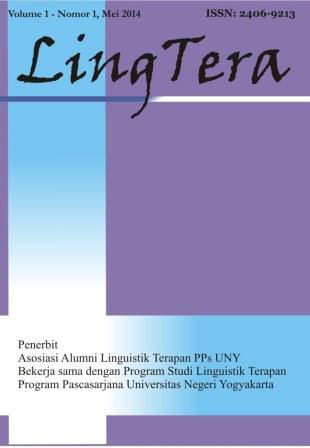Language learners' engagement in hybrid classroom settings: A systematic review
DOI:
https://doi.org/10.21831/lt.v10i1.59886Keywords:
students' engagement, online classroom, hybrid classroom, language learning, systematic reviewAbstract
References
Bonner, E., Garvey, K., Miner, M., Godin, S., & Reinders, H. (2022). Measuring real-time learner engagement in the Japanese EFL classroom. Innovation in Language Learning and Teaching. 1 (11). https://doi.org/10.1080/17501229.2021.2025379
D'Souza, R., Shet, J. P., Alanya-Beltran, J., Tongkachok, K., Hipolito-Pingol, G., & Sameem, M. A. M. (2021). "I Teach the way I believe": EFL teachers' pedagogical beliefs in technology integration and its relationship to students' motivation and engagement in the covid 19 pandemic year. International Journal of Learning, Teaching and Educational Research, 20(11), 387–406. https://doi.org/10.26803/ijlter.20.11.21
Dixson, M. D., Greenwell, M. R., Rogers-Stacy, C., Weister, T., & Lauer, S. (2017). Nonverbal immediacy behaviors and online student engagement: bringing past instructional research into the present virtual classroom. Communication Education, 66(1), 37–53. https://doi.org/10.1080/03634523.2016.1209222
Fredricks, J. A., Blumenfeld, P. C., & Paris, A. H. (2004). School Engagement: Potential of the concept, state of the evidence. Review of Educational Research, 74(1), 59-109.
Garwood, J. E. (2013). One-to-One Ipads in The Elementary Classroom: Measuring the Impact on Student Engagement, Instructional Practices, and Teacher Perception. A Dissertation.
Higgins, J. P., Thomas, J., Chandler, J., Cumpston, M., Li, T., Page, M. J., & Welch, V. A. (Eds.). (2019). Cochrane handbook for systematic reviews of interventions. John Wiley & Sons.
Hiver, P., Al-Hoorie, A. H., Vitta, J. P., & Wu, J. (2021a). Engagement in language learning: A systematic review of 20 years of research methods and definitions. Language Teaching Research. https://doi.org/10.1177/13621688211001289
Hiver, P., Al-Hoorie, A. H., Vitta, J. P., & Wu, J. (2021b). Engagement in language learning: A systematic review of 20 years of research methods and definitions. Language Teaching Research. https://doi.org/10.1177/13621688211001289
Hosseini, H. M., Fathi, J., Derakhshesh, A., & Mehraein, S. (2022). A model of classroom social climate, foreign language enjoyment, and student engagement among English as a foreign language learners. Frontiers in Psychology, 13. https://doi.org/10.3389/fpsyg.2022.933842
Incorporating E-portfolio with flipped classrooms: An in-depth analysis of students' speaking performance and learning engagement. JALT CALL Journal, 17(2), 93–111. https://doi.org/10.29140/JALTCALL.V17N2.378
Kusuma, I. P. I., Mahayanti, N. W. S., Adnyani, L. D. S., & Budiarta, L. G. R. (2021).
Lambert, C., & Zhang, G. (2019). Engagement in the Use of English and Chinese as Foreign Languages: The Role of Learner-Generated Content in Instructional Task Design. Modern Language Journal, 103(2), 391–411. https://doi.org/10.1111/modl.12560
Li, Z. (2022). Learner engagement in the flipped foreign language classroom: Definitions, debates, and directions of future research. Frontiers in Psychology, 13. https://doi.org/10.3389/fpsyg.2022.810701
Marks, H. M. (2000). Student engagement in instructional activity: patterns in the elementary, middle, and high school years. American educational research journal, 37(1), 153-184.
Mercer, S., & Dí¶rnyei, Z. (2020). Engaging Language Learners in Contemporary Classrooms. Cambridge University Press.
Mihai, M., Albert, C. N., Mihai, V. C., & Dumitras, D. E. (2022). Emotional and Social Engagement in the English Language Classroom for Higher Education Students in the COVID-19 Online Context. Sustainability (Switzerland), 14(8). https://doi.org/10.3390/su14084527
Mulrow, C. D. (1994). Systematic reviews: rationale for systematic reviews. Bmj, 309(6954), 597-599.
Nakamura, S., Phung, L., & Reinders, H. (2021). The effect of learner choice on l2 task engagement. Studies in Second Language Acquisition, 43(2), 428–431. https://doi.org/10.1017/S027226312000042X
Newmann, F. M. (1992). Student engagement and achievement in American secondary schools. Teachers College Press, 1234 Amsterdam Avenue, New York
Pasaribu, T. A., & Wulandari, M. (2022). EFL teacher candidates' Engagement in mobile-assisted flipped classroom. Turkish Online Journal of Distance Education, 22(3), 1-18.
Reschly, A. L., & Christenson, S. L. (2022a). Handbook of Research on Student Engagement. In Handbook of Research on Student Engagement. Springer International Publishing. https://doi.org/10.1007/978-3-031-07853-8
Reschly, A. L., & Christenson, S. L. (2022b). Jingle-Jangle Revisited: History and Further Evolution of the Student Engagement Construct. In A. L. Reschly & S. L. Christenson (Eds.), Handbook of Research on Student Engagement (Second Edition, pp. 3–24). Springer International Publishing. https://doi.org/10.1007/978-3-031-07853-8
Rojabi, A. R., Setiawan, S., Munir, A., Purwati, O., & Widyastuti. (2022). The Camera-on or Camera-off, Is it a Dilemma? Sparking Engagement, Motivation, and Autonomy Through Microsoft Teams Videoconferencing. International Journal of Emerging Technologies in Learning, 17(11), 174–189. https://doi.org/10.3991/ijet.v17i11.29061
Wei, Y. (2021). Enhancing Teacher–Student Interaction and Students' Engagement in a Flipped Translation Classroom. In Frontiers in Psychology (Vol. 12). Frontiers Media S.A. https://doi.org/10.3389/fpsyg.2021.764370
Zhou, Y., & Wei, M. (2018). Strategies in technology-enhanced language learning. Studies in Second Language Learning and Teaching, 8(2 Special Issue), 471–495. https://doi.org/10.14746/ssllt.2018.8.2.13
Downloads
Published
How to Cite
Issue
Section
Citation Check
License
LingTera allows readers to read, download, copy, distribute, print, search, or link to its articles' full texts and allows readers to use them for any other lawful purpose. The journal allows the author(s) to hold the copyright without restrictions. Finally, the journal allows the author(s) to retain publishing rights without restrictions.
- Authors are allowed to archive their submitted articles in an open-access repository.
- Authors are allowed to archive the final published article in an open-access repository with an acknowledgment of its initial publication in this journal.

Psychology, Evaluation, and Technology in Educational Research is licensed under a Creative Commons Attribution-ShareAlike 4.0 International License.
Based on a work at https://petier.org/index.php/PETIER.









